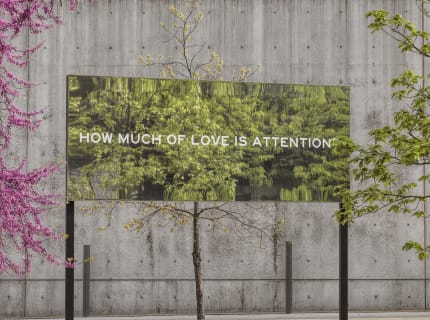Dear New Yorker, are you elated that museums have reopened but find yourself a bit queasy about being indoors with hundreds of other art lovers? There’s a very fine museum exhibition you can see now, in the flesh but outdoors.
The Studio Museum in Harlem, with construction of its new building in progress, was already organizing off-site exhibitions before the pandemic. And one of them, the New York artist Chloë Bass’s show, “Wayfinding,” remains on view at St. Nicholas Park through Sept. 27. With themes of caring and attention, it has become only more meaningful. And it is the first solo museum exhibition for the artist.
“Wayfinding” revolves around three questions: “How much of care is patience? How much of life is coping? How much of love is attention?” Three billboards, positioned throughout the park, pose these queries, in gray type on mirrored surfaces. They reflect the park and the surrounding city, and can thus almost disappear. The texts can be hard to see — as such questions can be hard to answer.
“I was creating at a monumental scale at a moment when monuments are seen as an imposition, or really haven’t aged well,” Ms. Bass said by phone. “I don’t live in Harlem, and I didn’t want to make something incorrect. Something that reflects your landscape as it’s changing offers a gentle interpretation of what the monument can mean.”
Wayfinding refers to architectural and graphic features that allow people to situate themselves — like signage in large government buildings or hospitals, for example. Ms. Bass’s signs along walkways bear reflective text on matte silver backgrounds. By repeating and varying wording, Ms. Bass explores various intimacies, some ominous. One reads, “There are times when I have agreed with you only in order to go to sleep.” Another: “There are times when I have agreed with you only in order to stay alive.”
The artist found herself interested in the ways urban dwellers orient themselves, especially when she learned that gentrifying urban environments can leave aging residents disoriented. A dryly funny 30-minute audio guide, accessible by a phone number given on a didactic panel, offers no specific guidance on moving through the park, but can be “emotionally orienting,” said the artist.
Ms. Bass started out studying the life of the individual, then expanded to investigate pairs. Writing in The New York Times in 2018, Will Heinrich described her multimedia gallery installation “Book of Everyday Instruction” as having an “elegant, unbalancing poetry.” She plans to expand to the level of the metropolis. With an urban park in a diverse neighborhood, she is partway there.
Life goes on around the art. One recent day, women took an exercise class; families cavorted on the playground; parks employees mowed the grass. One of them — trimming around the posts of the sign “How much of love is attention?” — appeared through his precise work to illustrate the text itself. He smiled at that notion and said, of his caretaking, “I was born in Harlem. I love to do it.”
Aiden J. Baptiste-Boissiere, a chef from Washington, D.C., who was visiting the park, said, “It gives you reason to pause and think and apply it to your life.”
“Some people forget kindness,” he added. “People close off. Be kinder to people.”
Read full article at nytimes.com.

